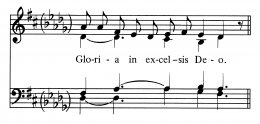Tyler Mitchell
2018-11-29 08:56:00 UTC
I'm trying to figure out how to add a "parenthesized" second key
signature to my music, something like this:
Loading Image...
I experimented with adding two \key commands one after the other,
but I get the error:
foo.ly:5:9: warning: Two simultaneous key-change events, junking this one
The following comes somewhat close, though there's a bit of an
undesirable gap between the two key signatures; and I can't figure
out how to increase the size of the parentheses; and I have to use
the 'second' key signature throughout to avoid a lot of unneeded
accidentals; and I wouldn't be able to use a time signature, as it
would be stuck between these two key signatures.
\version "2.18.2"
\relative c'' {
\key a \major
\once\override NoteHead.stencil = ##f
\once\override Stem.stencil = ##f
a4
% Doesn't seem to have any effect:
\override ParenthesesItem.font-size = #5
\parenthesize
\key aes \major
aes4
}
\layout { \context { \Staff printKeyCancellation = ##f \remove Time_signature_engraver } }
Any suggestions for how I should approach this?
A "stretch goal" would be to have accidentals handled automatically
in the same way, eg:
Loading Image...
But this seems a bit more involved (and unneeded, at least
initially).
Many thanks,
Tyler
signature to my music, something like this:
Loading Image...
I experimented with adding two \key commands one after the other,
but I get the error:
foo.ly:5:9: warning: Two simultaneous key-change events, junking this one
The following comes somewhat close, though there's a bit of an
undesirable gap between the two key signatures; and I can't figure
out how to increase the size of the parentheses; and I have to use
the 'second' key signature throughout to avoid a lot of unneeded
accidentals; and I wouldn't be able to use a time signature, as it
would be stuck between these two key signatures.
\version "2.18.2"
\relative c'' {
\key a \major
\once\override NoteHead.stencil = ##f
\once\override Stem.stencil = ##f
a4
% Doesn't seem to have any effect:
\override ParenthesesItem.font-size = #5
\parenthesize
\key aes \major
aes4
}
\layout { \context { \Staff printKeyCancellation = ##f \remove Time_signature_engraver } }
Any suggestions for how I should approach this?
A "stretch goal" would be to have accidentals handled automatically
in the same way, eg:
Loading Image...
But this seems a bit more involved (and unneeded, at least
initially).
Many thanks,
Tyler